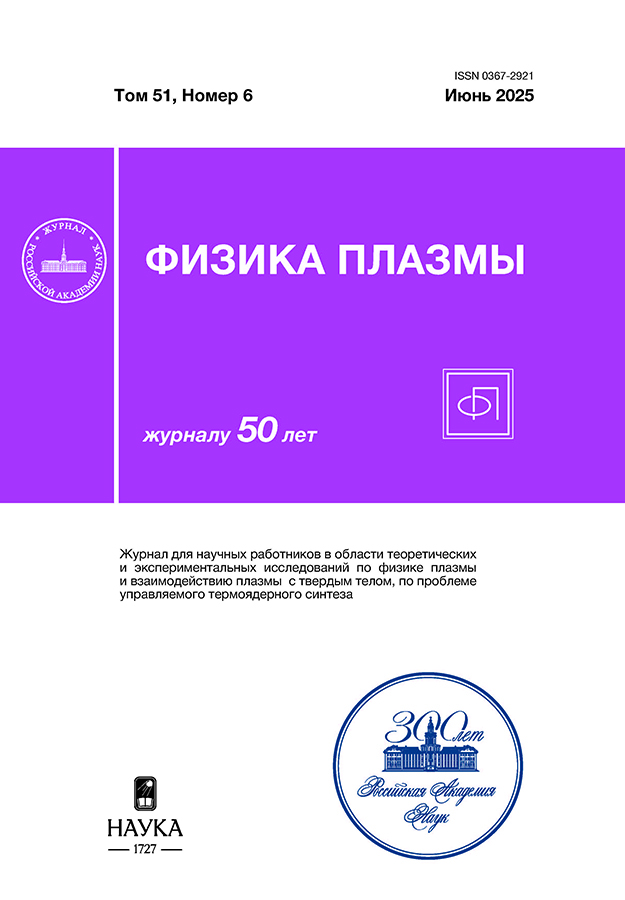Selection of dust particles in radio frequency inductive discharge
- Authors: Novikov L.А.1, Gasilov М.A.1, Golubev M.S.1, Morozova M.V.1, Dzlieva E.S.1, Pavlov S.I.1, Karasev V.Y.1
-
Affiliations:
- St. Petersburg State University
- Issue: Vol 50, No 8 (2024)
- Pages: 917-923
- Section: ПЫЛЕВАЯ ПЛАЗМА
- URL: https://ruspoj.com/0367-2921/article/view/677458
- DOI: https://doi.org/10.31857/S0367292124080068
- EDN: https://elibrary.ru/OBBVLC
- ID: 677458
Cite item
Abstract
Selection of dust particles in three-dimensional plasma–dust trap in the electrodeless radio frequency inductive discharge in neon was studied for the first time. The discharge conditions and the discharge chamber design were chosen so that the dust structures of polydisperse quartz particles are created in the resulting dust trap. The structure lengths were of up to 1.5 cm and the number of particles in them was of up to 4000. Statistical analysis of the sizes of trapped particles has shown that under the conditions chosen the average particle size is close to 4 μm, and in a wide range from 0.25 to 1.0 Torr, it weakly depends on neon pressure. It was found that in the three-dimensional dust structure formed, the longitudinal interparticle distance changes in anomalously wide range, as compared to the dust structures formed in plasma of glow discharge. The characteristic size of the trapped particles was estimated based on the vertical balance of forces acting on dust particle. It was shown that, in terms of a number of parameters, the method of particle selection in radio frequency inductive discharge is preferable, as compared to similar method used in glow discharges in strata, and the dust trap applied can be used for studying three-dimensional dusty plasmas in the magnetic field.
Full Text
About the authors
L. А. Novikov
St. Petersburg State University
Author for correspondence.
Email: l.novikov@spbu.ru
Russian Federation, St. Petersburg
М. A. Gasilov
St. Petersburg State University
Email: l.novikov@spbu.ru
Russian Federation, St. Petersburg
M. S. Golubev
St. Petersburg State University
Email: l.novikov@spbu.ru
Russian Federation, St. Petersburg
M. V. Morozova
St. Petersburg State University
Email: l.novikov@spbu.ru
Russian Federation, St. Petersburg
E. S. Dzlieva
St. Petersburg State University
Email: l.novikov@spbu.ru
Russian Federation, St. Petersburg
S. I. Pavlov
St. Petersburg State University
Email: l.novikov@spbu.ru
Russian Federation, St. Petersburg
V. Yu. Karasev
St. Petersburg State University
Email: plasmadust@ya.ru
Russian Federation, St. Petersburg
References
- Chu J.H., Lin I. // Phys. Rev. Lett. 1994. V. 72. P. 4009. https://doi.org/10.1103/PhysRevLett.72.4009
- Thomas H., Morfill G.E., Demmel V., et al. // Phys. Rev. Lett. 1994. V. 73 (5). P. 652.https://doi.org/10.1103/PhysRevLett.73.652
- Hayashi Y. Structure of a Three-Dimensional Coulomb Crystal in a Fine-Particle Plasma. Phys Rev Lett. 1999. V. 83. 4764.https://doi.org/10.1103/PhysRevLett.83.4764
- Фортов В., Морфилл Г., eds. Комплексная и пылевая плазма: Из лаборатории в космос. М.: Физматлит, 2012.
- Morfill G.E., Thomas H.M., Konopka U., Zuzic M. // Phys. Plasmas. 1999. V. 6. P. 1769.https://doi.org/10.1063/1.873435
- Vasilieva E.V., Petrov O.F., Vasiliev M.M. // Sci. Rep. 2021. V. 11. P. 523.ht tps://doi.org/10.1038/s41598-020-80082-x
- Липаев А. М., Молотков В. И., Нефедов А. П. и др. // ЖЭТФ. 1997. Т. 112. С. 2030.
- Dzlieva E. S., Ermolenko M. A., Karasev V. Yu. // Tech. Phys. 2012. V. 57. P. 145.ht tps://doi.org/10.1134/S1063784212010070
- Дзлиева Е. С., Ермоленко М. А., Карасев В. Ю. // Физика плазмы. 2012. Т. 38. С. 591.
- Dzlieva E. S., D ’ yachkov L. G., Novikov L. A., et al. // Plasma Sources Sci. Technol. 2019. V. 28. P. 085020.ht tps://doi.org/10.1088/1361-6595/ab36ac
- Dzlieva E.S., D’yachkov L.G., Novikov L.A., et al. // Molecules. 2021. Т. 26. С. 3788.ht tps://doi.org/10.3390/molecules26133788
- Choudhary M., Bergert R., Moritz S., et al. // Contrib. Plasma Phys. 2021. V. 61. P. e202000110.htt ps://doi.org/10.1002/ctpp.202000110
- Герасимов Ю. В., Нефедов А. П., Синельщиков В. А., Фортов В. Е. // ПЖТФ. 1998. Т. 24. С. 62.
- Fortov V.E., Petrov O.F., Usachev A.D., Zobnin A.V. // Phys. Rev. E. 2004. V. 70. P. 046415.https://doi.org/10.1103/PhysRevE.70.046415
- Дзлиева Е. С., Карасев В. Ю., Эйхвальд А. И. // Опт. и спектр. 2002. Т. 92. С. 1018.
- Карасев В. Ю., Дзлиева Е. С., Павлов С. И. и др. // ЖТФ. 2019. Т. 89 (1). С. 50.ht tps://doi.org/10.21883/JTF.2019.01.46961.71-18
- Грановский В. Л. Электрический ток в газе. Установившийся ток. М.: Наука, 1971.
- Райзер Ю. П. Физика газового разряда. М.: Наука, 1992.
- Кудрявцев А. А., Смирнов А. С., Цендин Л. Д. Физика тлеющего разряда. СПб.: Лань, 2010.
- Голубовский Ю. Б., Кудрявцев А. А., Некучаев В. О., и др. Кинетика электронов в неравновесной газоразрядной плазме. СПб.: СПбГУ, 2004.
- Stoffels W.W., Stoffels E., Swinkels G.H.P.M., et al. // Phys. Rev. E. 1999. V. 59. P. 2302.ht tps://doi.org/10.1103/PhysRevE.59.2302
- Кралькина Е. А. // УФН. 2008. Т. 178. С. 519.ht tps://doi.org/10.3367/UFNr.0178.200805f.0519
- Майоров С. А. // Физика плазмы. 2009. Т. 35. С. 869.
- Недоспасов А. В., Хаит В. Д. Колебания и неустойчивости низкотемпературной плазмы. М.: Наука, 1979.
- Kersten H., Deutsch H., Otte M., et al. // Thin Solid Films. 2000. V. 377–378. P. 530.ht tps://doi.org/10.1016/S0040-6090(00)01439-5
- Karasev V.Yu., Dzlieva E.S., Pavlov S.I. // EPL. 2015. V. 110. P. 55002.ht tps://doi.org/10.1209/0295-5075/110/55002
- Карасев В. Ю., Дзлиева Е. С., Эйхвальд А. И. // Опт. и спектр. 2006. Т. 101. С. 521.
- Дзлиева Е. С., Ермоленко М. А., Карасев В. Ю. // ЖТФ. 2012. Т. 82 (7). С. 51.
- Дзлиева Е. С., Майоров С. А., Новиков Л. А., и др. // Физика плазмы. 2022. Т. 48. С. 914.https://doi.org/10.31857/S0367292122600741
- Петров О.Ф., Усачев А.Д., Зобнин А.В. // Научные труды Института теплофизики экстремальных состояний ОИВТ РАН / Под. ред. В.Е. Фортова и А.П. Лихачева. М.: ОИВТ РАН, 2004. Вып. 6. С. 267.
- Fortov V.E., Nefedov A.P., Sinel’shchikov V.A., et al. // Phys. Lett. A. 2000. V. 267 P. 179.https://doi.org/10.1016/S0375-9601(00)00072-4
- Fortov V.E., Khrapak A.G., Khrapak S.A., et al. // Usp. Fiz. Nauk. 2004. V. 174. P. 495.https://doi.org/10.3367/UFNr.0174.200405b.0495
- Василяк Л. М., Ветчинин С. П., Поляков Д. Н., Фортов В. Е. // ЖЭТФ. 2005. Т. 127. С. 1166.
Supplementary files
















